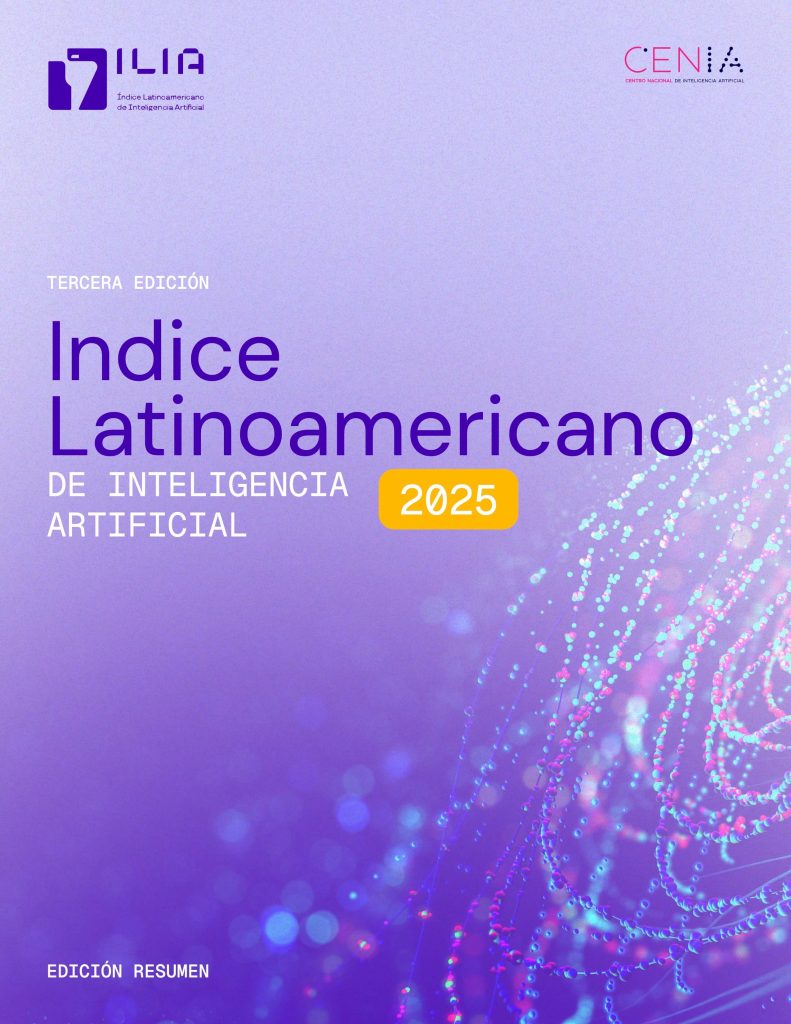
The Research, Development, and Adoption (R+D+A) dimension evaluates the ecosystem of research, development, innovation, and adoption at the public, private, and academic levels. The R+D+A dimension is composed of three subdimensions: Research, Innovation and Development, and Adoption.
This dimension has a weight of 35% of the total score, being the second most important according to the assigned weighting.
The Research, Development, and Adoption (R+D+A) dimension evaluates the ecosystem of research, development, innovation, and adoption at the public, private, and academic levels. The R+D+A dimension is composed of three subdimensions: Research, Innovation and Development, and Adoption.
This dimension has a weight of 35% of the total score, being the second most important according to the assigned weighting.
Equity Advances, but Parity Remains Distant: Women’s Participation in AI Research
Women’s participation in artificial intelligence research has grown significantly across all countries this year. The regional average increased from 19.8% to 23.6%, led by Cuba (32%), Panama (30%), and Argentina (28%), followed by the Bolivarian Republic of Venezuela (27%), Ecuador (27%), and Honduras (26%).
Despite this progress, the gender gap remains substantial: no country has surpassed one-third female representation, and in most countries, women account for fewer than one in four AI researchers.
Increasing women’s involvement is crucial to improving the quality of algorithmic systems, bringing diverse perspectives, experiences, and approaches.

Without consistent long-term policies to sustain these advances, the gap may remain or even widen, turning current progress into a short-lived milestone.
Academia Emerges as a Strategic Pillar of the AI Ecosystem

The steady growth of the AI academic community in Latin America and the Caribbean demonstrates a vibrant and expanding knowledge base. The average number of AI researchers increased by more than 10%, from 20,082 in the previous edition to 23,191 in this edition. Meanwhile, the number of researchers who consistently publish AI-related work rose from 3,356 to 3,446.
To translate academic strength into technological development, this momentum must be supported by talent-retention policies, stronger collaboration between academia and industry, and greater support for applied research.
Without such coordination, research outputs risk becoming disconnected from the region’s most pressing social and economic needs.
Generative AI: A Catalyst to Democratize AI for Public Benefit
Adoption of generative AI in countries like Uruguay, Chile, Peru, Costa Rica, and the Dominican Republic, where usage surpasses the regional average, shows that AI access is no longer confined to the largest technology ecosystems.
Generative AI tools have lowered entry barriers, enabling non-expert users to experiment with and apply advanced models through accessible interfaces such as large language models (LLMs).
This democratization of access could accelerate the spread of AI in key areas such as education, government services, and small and medium-sized enterprises (SMEs).
To fully harness these opportunities, countries will need to build critical skills related to privacy, accuracy, bias, and responsible use.
Peru: An Emerging Leader in Cross-Cutting AI Adoption
Peru leads the region in web traffic to AI-related platforms and in the intensity of usage of more advanced AI tools. Peruvian users average six visits to AI websites per person, twice the regional average.

This behavior offers valuable insights into real-world adoption, reflecting engagement with AI-based web services among non-specialist users.
Growing traffic to AI tools indicates broader access to intelligent solutions, paving the way for accelerated adoption with widespread potential benefits.
Citizen Participation with AI: A Missed Opportunity
Despite its potential to transform democratic participation, AI remains underused in civic engagement and digital democracy tools across the region. Although countries such as Colombia, Mexico, and Peru demonstrate higher implementation, 8 of the 19 ILIA countries report no use cases at all.
This gap reflects a disconnect between governmental interest in emerging technologies, often limited to informational chatbots, and practical applications that support consultation, accountability, and collaborative policy-making.
Investing in civic-oriented AI –reliable, responsible, and secure– could enhance democratic quality and strengthen institutional trust. The challenge is not technological but institutional and political, revealing a missed opportunity to deepen democratic participation through digital innovation.
Open Source as a Regional Strategy for Technological Collaboration
The open-source model continues to offer significant opportunities for AI development in the region. It enables the creation of local solutions without reliance on proprietary licenses or costly infrastructure, while fostering collaborative development across the developer community.
The strong performance of countries such as Honduras, El Salvador, and Cuba, excelling in productivity, quality, and relevance of open-source contributions, illustrates the potential this model offers to all nations in the region.
Open-source development strengthens regional cooperation, collective learning, and algorithmic transparency.
A coordinated regional strategy to promote open-source AI could reduce costs, accelerate results, improve interoperability, and expand distributed technical capabilities across countries.

Innovation is Limited and Concentrated in a Few Countries
AI investment and company creation remain highly concentrated, revealing a fragile innovation ecosystem across Latin America and the Caribbean.
Chile, Uruguay, Brazil, Mexico, and Colombia account for nearly all AI investments and startups in the region, while Argentina stands out by representing more than half of the region’s total estimated AI investment value.
Despite this concentration, the overall level of investment remains low: the entire region accounts for just 1.12% of global AI investment, roughly seven times lower than its share of global GDP. This gap underscores the need to stimulate innovation capacity beyond a handful of leading economies.
Despite this concentration, the overall level of investment remains low: the entire region accounts for just 1.12% of global AI investment, roughly seven times lower than its share of global GDP. This gap underscores the need to stimulate innovation capacity beyond a handful of leading economies.

Where Are the Unicorns?
Only six countries in the region are home to unicorn companies: Chile, Brazil, Mexico, Colombia, Ecuador, and Argentina.
This scarcity may reflect not only limited funding, but also restrictive regulatory frameworks, low risk tolerance, weak entrepreneurial culture, and insufficient collaboration between academia and industry.
Closing this gap requires a systemic approach that includes stronger incentives for entrepreneurship, more robust incubation and acceleration programs, public-private venture funds, and policies that promote technology-driven entrepreneurship with a regional outlook.

The Future of Work: Tasks Can Be Accelerated; People Cannot Be Replaced
Nearly every occupation includes tasks that can be accelerated by generative AI, meaning the transformative potential of this technology extends to all workers.
Rather than replacing jobs, generative AI serves to streamline processes with particularly high potential in highly skilled roles.
A recent report on AI and the future of work in Chile shows that an average of 48% of tasks could be accelerated, revealing both broad applicability and significant variation across sectors. Fields such as education, the public sector, and SMEs stand to benefit the most.
These findings highlight the opportunity to design inclusive adoption strategies, with differentiated approaches to training and implementation tailored to each sector’s needs.
Science: Three Paths to Adopting AI in Research
AI adoption within the scientific and academic community does not follow a single trajectory.
Instead, researchers tend to cluster into three user profiles: functional users, who apply AI primarily to automate tasks; integrators, who treat AI as a transformative partner in research; and critical users, who adopt cautiously, with a strong ethical and political lens.
These different forms of technological appropriation vary in depth of integration, purpose, and ethical positioning, revealing gaps in access, skills, and innovation readiness.
Recognizing this diversity is essential for designing training, adoption, and governance strategies that align with the realities and needs of the regional scientific ecosystem.

Recognizing this diversity is essential for designing training, adoption, and governance strategies that align with the realities and needs of the regional scientific ecosystem.
Women’s participation in artificial intelligence research has grown significantly across all countries this year. The regional average increased from 19.8% to 23.6%, led by Cuba (32%), Panama (30%), and Argentina (28%), followed by the Bolivarian Republic of Venezuela (27%), Ecuador (27%), and Honduras (26%).
Despite this progress, the gender gap remains substantial: no country has surpassed one-third female representation, and in most countries, women account for fewer than one in four AI researchers.
Increasing women’s involvement is crucial to improving the quality of algorithmic systems, bringing diverse perspectives, experiences, and approaches. Without consistent long-term policies to sustain these advances, the gap may remain or even widen, turning current progress into a short-lived milestone.
The steady growth of the AI academic community in Latin America and the Caribbean demonstrates a vibrant and expanding knowledge base. The average number of AI researchers increased by more than 10%, from 20,082 in the previous edition to 23,191 in this edition. Meanwhile, the number of researchers who consistently publish AI-related work rose from 3,356 to 3,446.
To translate academic strength into technological development, this momentum must be supported by talent-retention policies, stronger collaboration between academia and industry, and greater support for applied research. Without such coordination, research outputs risk becoming disconnected from the region’s most pressing social and economic needs.
La expansión sostenida de la comunidad académica en IA en los países de América Latina y el Caribe es una señal de una academia que crece y no se estanca. El promedio de investigadores de IA ha aumentado más de un 10% de 20.082 en la versión anterior, a 23.191 en esta edición, mientras que los investigadores que publican consistentemente en IA de 3.356 a 3.446 en el mismo periodo. Esta consolidación académica debe ir acompañada de políticas de retención, vínculo con el sector productivo y apoyo a la investigación aplicada. Sin esta articulación, la producción científica corre el riesgo de quedar desconectada de los desafíos sociales y económicos más urgentes de la región.
Adoption of generative AI in countries like Uruguay, Chile, Peru, Costa Rica, and the Dominican Republic, where usage surpasses the regional average, shows that AI access is no longer confined to the largest technology ecosystems.
Generative AI tools have lowered entry barriers, enabling non-expert users to experiment with and apply advanced models through accessible interfaces such as large language models (LLMs). This democratization of access could accelerate the spread of AI in key areas such as education, government services, and small and medium-sized enterprises (SMEs).
To fully harness these opportunities, countries will need to build critical skills related to privacy, accuracy, bias, and responsible use.
Peru leads the region in web traffic to AI-related platforms and in the intensity of usage of more advanced AI tools. Peruvian users average six visits to AI websites per person, twice the regional average.
This behavior offers valuable insights into real-world adoption, reflecting engagement with AI-based web services among non-specialist users. Growing traffic to AI tools indicates broader access to intelligent solutions, paving the way for accelerated adoption with widespread potential benefits.
Despite its potential to transform democratic participation, AI remains underused in civic engagement and digital democracy tools across the region. Although countries such as Colombia, Mexico, and Peru demonstrate higher implementation, 8 of the 19 ILIA countries report no use cases at all.
This gap reflects a disconnect between governmental interest in emerging technologies, often limited to informational chatbots, and practical applications that support consultation, accountability, and collaborative policy-making.
Investing in civic-oriented AI –reliable, responsible, and secure– could enhance democratic quality and strengthen institutional trust. The challenge is not technological but institutional and political, revealing a missed opportunity to deepen democratic participation through digital innovation.
The open-source model continues to offer significant opportunities for AI development in the region. It enables the creation of local solutions without reliance on proprietary licenses or costly infrastructure, while fostering collaborative development across the developer community.
The strong performance of countries such as Honduras, El Salvador, and Cuba, excelling in productivity, quality, and relevance of open-source contributions, illustrates the potential this model offers to all nations in the region. Open-source development strengthens regional cooperation, collective learning, and algorithmic transparency.
A coordinated regional strategy to promote open-source AI could reduce costs, accelerate results, improve interoperability, and expand distributed technical capabilities across countries.
AI investment and company creation remain highly concentrated, revealing a fragile innovation ecosystem across Latin America and the Caribbean. Chile, Uruguay, Brazil, Mexico, and Colombia account for nearly all AI investments and startups in the region, while Argentina stands out by representing more than half of the region’s total estimated AI investment value.
Despite this concentration, the overall level of investment remains low: the entire region accounts for just 1.12% of global AI investment, roughly seven times lower than its share of global GDP. This gap underscores the need to stimulate innovation capacity beyond a handful of leading economies.
Only six countries in the region are home to unicorn companies: Chile, Brazil, Mexico, Colombia, Ecuador, and Argentina. This scarcity may reflect not only limited funding, but also restrictive regulatory frameworks, low risk tolerance, weak entrepreneurial culture, and insufficient collaboration between academia and industry.
Closing this gap requires a systemic approach that includes stronger incentives for entrepreneurship, more robust incubation and acceleration programs, public-private venture funds, and policies that promote technology-driven entrepreneurship with a regional outlook.
Nearly every occupation includes tasks that can be accelerated by generative AI, meaning the transformative potential of this technology extends to all workers. Rather than replacing jobs, generative AI serves to streamline processes with particularly high potential in highly skilled roles.
A recent report on AI and the future of work in Chile shows that an average of 48% of tasks could be accelerated, revealing both broad applicability and significant variation across sectors. Fields such as education, the public sector, and SMEs stand to benefit the most.
These findings highlight the opportunity to design inclusive adoption strategies, with differentiated approaches to training and implementation tailored to each sector’s needs.
AI adoption within the scientific and academic community does not follow a single trajectory. Instead, researchers tend to cluster into three user profiles: functional users, who apply AI primarily to automate tasks; integrators, who treat AI as a transformative partner in research; and critical users, who adopt cautiously, with a strong ethical and political lens.
These different forms of technological appropriation vary in depth of integration, purpose, and ethical positioning, revealing gaps in access, skills, and innovation readiness. Recognizing this diversity is essential for designing training, adoption, and governance strategies that align with the realities and needs of the regional scientific ecosystem.
Measures each country’s capacity to generate new academic knowledge in the field of artificial intelligence, an aspect closely related to the maturity of the local ecosystem in training and talent development.
Addresses AI advancements within the local innovation and development ecosystem, such as the number of AI companies, private investment, entrepreneurial environment, and open-source development work.
Evaluates the progress of AI integration in processes, operations, products, or services within a country, including government, private sector, civil society, and citizens in general.

Access the 2025 edition of ILIA and learn about the main findings on the state of AI in Latin America and the Caribbean.